Unprecedentedly wide and sharp dark matter map
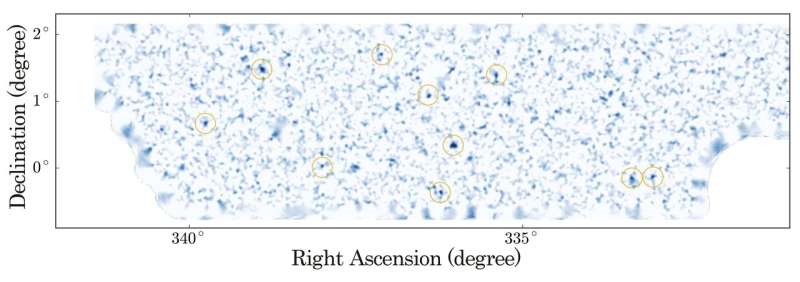
A research team of multiple institutes, including the National Astronomical Observatory of Japan and University of Tokyo, released an unprecedentedly wide and sharp dark matter map based on the newly obtained imaging data by Hyper Suprime-Cam on the Subaru Telescope. The dark matter distribution is estimated by the weak gravitational lensing technique (Figure 1, Movie). The team located the positions and lensing signals of the dark matter halos and found indications that the number of halos could be inconsistent with what the simplest cosmological model suggests. This could be a new clue to understanding why the expansion of the Universe is accelerating.
Mystery of the accelerated Universe
In the 1930's, Edwin Hubble and his colleagues discovered the expansion of the Universe. This was a big surprise to most of the people who believed that the Universe stayed the same throughout eternity. A formula relating matter and the geometry of space-time was required in order to express the expansion of the Universe mathematically. Coincidentally, Einstein had already developed just such a formula. Modern cosmology is based on Einstein's theory for gravity.
It had been thought that the expansion is decelerating over time (blue and red lines in Figure 2) because the contents of the Universe (matter) attract each other. But in the late 1990's, it was found that the expansion has been accelerating since about 8 Giga years ago. This was another big surprise which earned the astronomers who found the expansion a Nobel Prize in 2011. To explain the acceleration, we have to consider something new in the Universe which repels the space.
The simplest resolution is to put the cosmological constant back into Einstein's equation. The cosmological constant was originally introduced by Einstein to realize a static universe, but was abandoned after the discovery of the expansion of the Universe. The standard cosmological model (called LCDM) incorporates the cosmological constant. The expansion history using LCDM is shown by the green line in Figure 2. LCDM is supported by many observations, but the question of what causes the acceleration still remains. This is one of the biggest problems in modern cosmology.
Wide and deep imaging survey using Hyper Suprime-Cam
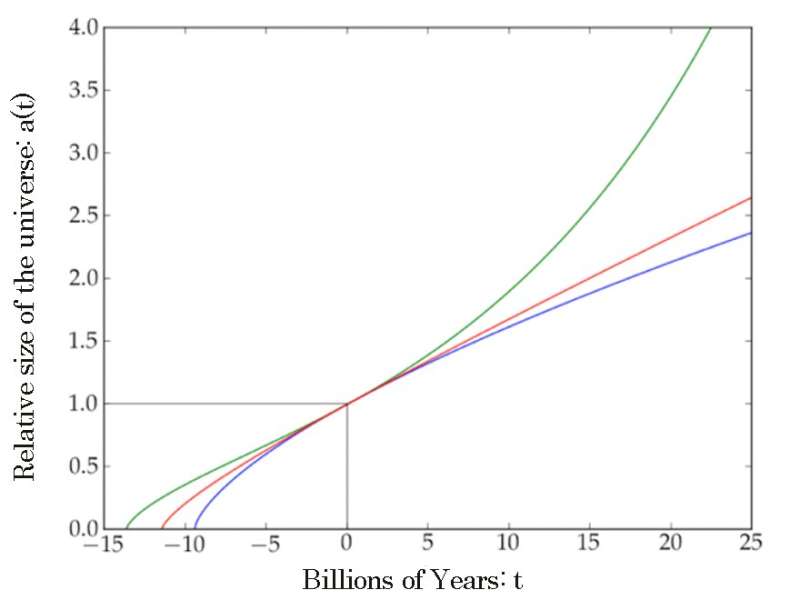
The team is leading a large scale imaging survey using Hyper Suprime-Cam (HSC) to probe the mystery of the accelerating Universe. The key here is to examine the expansion history of the Universe very carefully.
In the early Universe, matter was distributed almost but not quite uniformly. There were slight fluctuations in the density which can now be observed through the temperature fluctuations of the cosmic microwave background. These slight matter fluctuations evolved over cosmic time because of the mutual gravitational attraction of matter, and eventually the large scale structure of the present day Universe become visible. It is known that the growth rate of the structure strongly depends on how the Universe expands. For example, if the expansion rate is high, it is hard for matter to contract and the growth rate is suppressed. This means that the expansion history can be probed inversely through the observation of the growth rate.
It is important to note that growth rate cannot be probed well if we only observe visible matter (stars and galaxies). This is because we now know that nearly 80 % of the matter is an invisible substance called dark matter. The team adopted the 'weak gravitation lensing technique." The images of distant galaxies are slightly distorted by the gravitational field generated by the foreground dark matter distribution. Analysis of the systematic distortion enables us to reconstruct the foreground dark matter distribution.
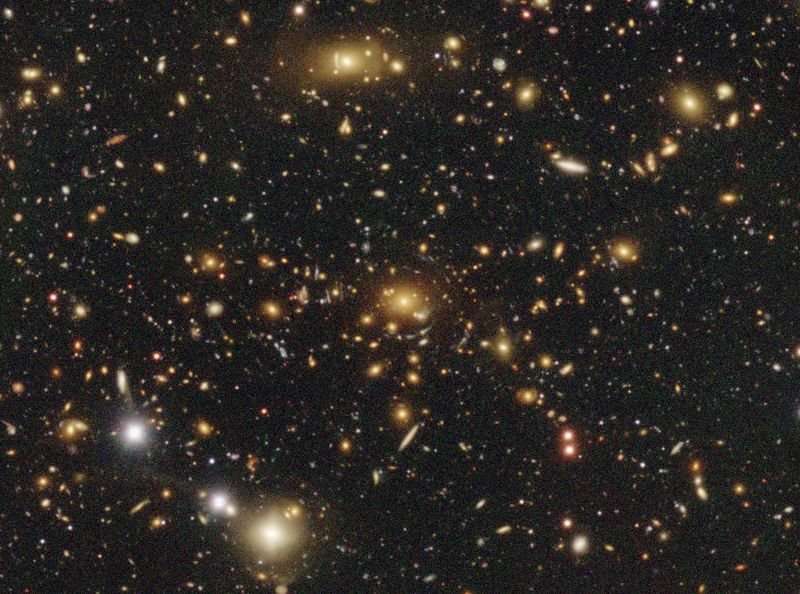
This technique is observationally very demanding because the distortion of each galaxy is generally very subtle. Precise shape measurements of faint and apparently small galaxies are required. This motivated the team to develop Hyper Suprime-Cam. They have been carrying out a wide field imaging survey using Hyper Suprime-Cam since March 2014. At this writing in February 2018, 60 % of the survey has been completed.
Unprecedentedly wide and sharp dark matter map
In this release, the team presents the dark matter map based on the imaging data taken by April 2016 (Figure 1). This is only 11 % of the planned final map, but it is already unprecedentedly wide. There has never been such a sharp dark matter map covering such a wide area.
Imaging observations are made through five different color filters. By combining these color data, it is possible to make a crude estimate of the distances to the faint background galaxies (called photometric redshift). At the same time, the lensing efficiency becomes most prominent when the lens is located directly between the distant galaxy and the observer. Using the photometric redshift information, galaxies are grouped into redshift bins. Using this grouped galaxy sample, dark matter distribution is reconstructed using tomographic methods and thus the 3-D distribution can be obtained. Figure 4 shows one such example. Data for 30 square degrees are used to reconstruct the redshift range between 0.1 (~1.3 G light-years) and 1.0 (~8 G light-years). At the redshift of 1.0, the angular span corresponds to 1.0 G x 0.25 G light-years. This 3-D dark matter mass map is also quite new. This is the first time the increase in the number of dark matter halos over time can be seen observationally.
What the dark matter halo count suggests and future prospects
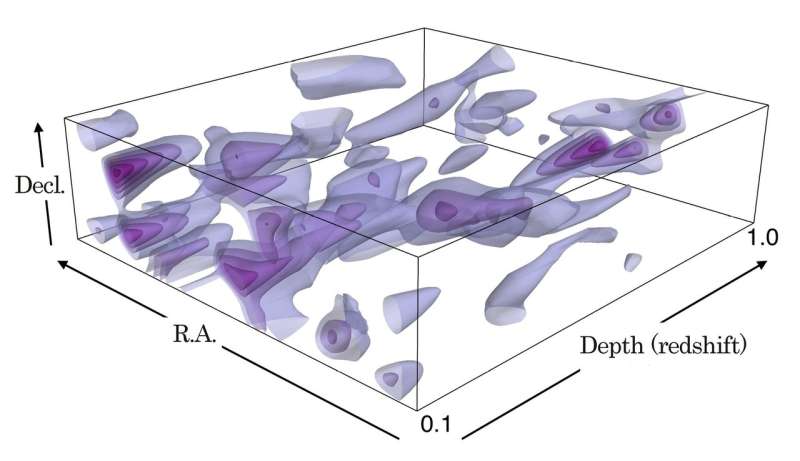
The team counted the number of dark matter halos whose lensing signal is above a certain threshold. This is one of the simplest measurements of the growth rate. The histogram (black line) in Figure 5 shows the observed lensing signal strength versus the number of observed halos whereas the model prediction is shown by the solid red line. The model is based on the standard LCDM model using the observation of cosmic microwave background as the seed of the fluctuations. The figure suggests that the number count of the dark matter halos is less than what is expected from LCDM. This could indicate there is a flaw in LCDM and that we might have to consider an alternative rather than the simple cosmological constant.
The statistical significance is, however, still limited as the large error bars (vertical line on the histogram in Figure 5) suggest. There has been no conclusive evidence to reject LCDM, but many astronomers are interested in testing LCDM because discrepancies can be a useful probe to unlock the mystery of the accelerating Universe. Further observation and analysis are needed to confirm the discrepancy with higher significance. There are some other probes of the growth rate and such analysis are also underway (e.g. angular correlation of galaxy shapes) in the team to check the validity of standard LCDM.
These results were published on January 1, 2018 in the HSC special issue of the Publications of the Astronomical Society of Japan. The report is titled "A large sample of shear-selected clusters from the Hyper Suprime-Cam Subaru Strategic Program S16A Wide field mass maps."
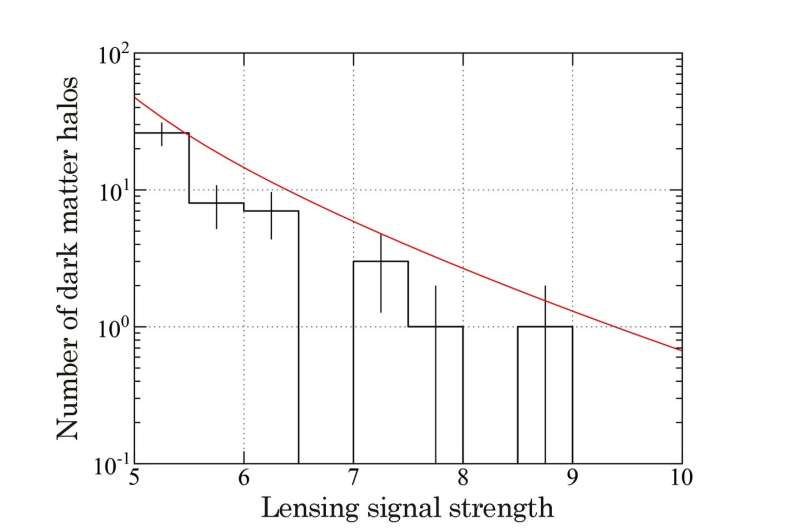
More information: A large sample of shear selected clusters from the Hyper Suprime-Cam Subaru Strategic Program S16A wide field mass maps. arxiv.org/abs/1802.10290v1
Provided by Subaru Telescope





















